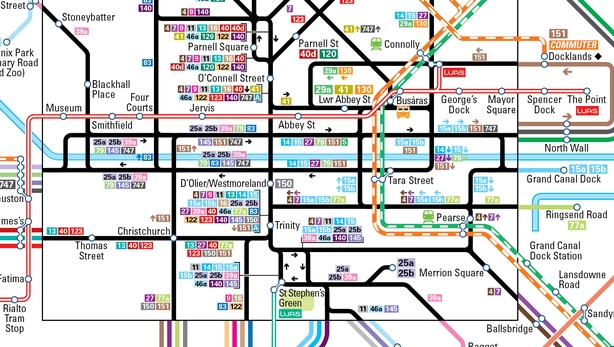Dublin Bus services will increase by 27% as part of a "transformative" redesign of the network according to the National Transport Authority (NTA).
The new system will involve "super frequency spines" providing buses every five to seven-and-a-half minutes, and an increased number of orbital routes.
It would involve less routes overall while some people would lose direct bus routes and have to change buses to get to the city centre, but the NTA said most of these commuters would have reduced journey times overall.
According to the NTA, the new system will mean nearly one million people working within 400 metres of a bus service with a frequency of 15 minutes or better – an increase of 31%.
The NTA said the existing system is complex with overlapping routes, not enough orbital routes and not enough integration with other forms of public transport.
The new system will involve seven cross-city "super frequency spines" designated A to G, and will have branches going to areas off the main route.
For example, super spine route A will go to Terenure while A1 will go to Knocklyon and A4 to Rathfarnham.

There will be 11 new orbital routes with 15-minute frequency servicing the north, west and south of the network. The new system will also provide local or feeder services of lesser frequency.
There will be a simplified fare structure with a 90-minute Leap card fare covering Dart, Luas, as well as bus, where the last leg starts within 90 minutes of the start of the journey.
There will also be a new fare for short distances.
NTA Chief executive Anne Graham said the present bus network was "complex" with 130 different routes that were focused on the city centre and few orbital routes.
"We believe that a system with greater scope for interconnection between routes, and where connecting passengers don’t necessarily have to travel to the city centre, is one that would be far more attractive and convenient," she said.
The proposals are contained in the Dublin Area Bus Network Redesign Public Consultation report by US-based public transport consultant Jarrett Walker and it follows a period of consultation.
There will now be a formal period of consultation from 16 July for nine weeks until 14 September.
Dublin Bus Chief Executive Ray Coyne said the network design was a significant opportunity and represented a change for everyone in the city.
The route redesign, along with proposed works to build 16 core bus corridors, are part of the Bus Connects project that will involve €2 billion investment up to 2027.





